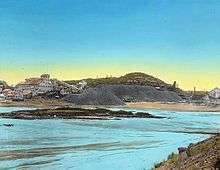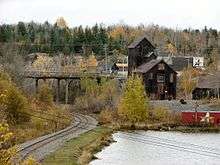Cobalt, Ontario
| Cobalt | |
|---|---|
| Town (single-tier) | |
| Town of Cobalt | |
 | |
| Nickname(s): Silver City | |
 Cobalt | |
| Coordinates: 47°24′N 79°41′W / 47.400°N 79.683°WCoordinates: 47°24′N 79°41′W / 47.400°N 79.683°W | |
| Country |
|
| Province |
|
| District | Timiskaming |
| Government | |
| • Mayor | Tina Sartoretto |
| • Governing Body | Cobalt Town Council |
| • MPs | Jay Aspin (CPC) |
| • MPPs | John Vanthof (ONDP) |
| Area[1] | |
| • Land | 2.05 km2 (0.79 sq mi) |
| Population (2011)[1] | |
| • Total | 1,133 |
| • Density | 553.0/km2 (1,432/sq mi) |
| Time zone | EST (UTC-5) |
| • Summer (DST) | EDT (UTC-4) |
| Postal code | P0J 1C0 |
| Area code(s) | 705 |
| Website | www.cobalt.ca |
Cobalt is a town in the district of Timiskaming, province of Ontario, Canada, with a population of 1,133 (as per the Canada 2011 Census.)
In 2001 Cobalt was named "Ontario's Most Historic Town" by a panel of judges on the TV Ontario program Studio 2, and in 2002 the "Cobalt Mining District" was designated a National Historic Site of Canada.[2]
History
.jpg)

W.E. Logan discovered cobalt in 1884 at the future site of the Agaunico Mine, one mile south of Haileybury.[3]
Silver was discovered in the area in the summer of 1903, during the construction of the Temiskaming & Northern Ontario Railway from North Bay to the communities of Haileybury and New Liskeard, north of Cobalt. The discovery of high-grade ore in the subsequent Cobalt silver rush led to the development of the McKinley Darragh, LaRose, Nipissing, and O'Brien silver mines. In 1904, Willet Miller, on a visit to Mile 104 on the T&NO, along with the Timmins brothers, named the future town Cobalt. The Timmins brothers bought the remaining Fred Larose claims and put up some cabins.[3]:18 By 1908, the camp was considered the world's largest producer of silver and cobalt.[4]
Within a few years the area was one of the largest silver producing areas in the world. Speculation over mining stocks on Wall Street in New York City required mounted police to control the crowds. The town was incorporated in 1906.[3]:32,40
Its population swelled and peaked at 7,000. In 1911, silver production exceeded 30,000,000 ounces (937.5 tons). Mining continued until the 1930s, then slowed to a trickle. Activity renewed in the 1950s then slowly dropped off, and there are no longer any operating mines in the area. However, one mill still operates in the area, and exploration for diamonds and other minerals is ongoing.
The silver mines of Cobalt, and the prospectors and miners that discovered them and worked the mines, have left an indelible mark on Canadian history, and the town is known as the birthplace of hard rock mining in Canada. The ore in Cobalt was close to surface, which meant that men with limited experience could prospect and begin mining, and then hone their skills as the mines went deeper. Those who learned their trade in Cobalt moved north, discovering gold in Kirkland Lake and Timmins and further afield in Canada and around the world. The mining in Cobalt was done with the use of wheelbarrows, pickaxes, hand steel and dynamite.
Cobalt suffered two devastating fires in the 20th century. In 1909, a fire in a cafe spread quickly through debris and garbage-filled alleyways. Half the town was destroyed; 150 buildings were lost and 3000 residents left homeless. Fire protection at the time was inadequate and firefighters were forced to dynamite buildings to create a firebreak.[5] On a hot and windy Victoria Day in 1977, a discarded cigarette started a fire that destroyed 140 buildings and left over 400 homeless. [6] [7]
The Cobalt Silver Kings played in the inaugural 1910 NHA season.
Cobalt, Haileybury, and New Liskeard were formerly known as the Tri-Towns. When Haileybury and New Liskeard were amalgamated into the city of Temiskaming Shores in 2004, Cobalt decided to remain a separate town. However, the two municipalities continue to have a close relationship, including the operation of a shared public transit system.
Demographics
| Canada census – Cobalt, Ontario community profile | |||
|---|---|---|---|
| 2011 | 2006 | 2001 | |
| Population: | 1133 (-7.4% from 2006) | 1223 (0.0% from 2001) | 1229 (-12.3% from 1996) |
| Land area: | 2.05 km2 (0.79 sq mi) | 2.11 km2 (0.81 sq mi) | 2.11 km2 (0.81 sq mi) |
| Population density: | 553.0/km2 (1,432/sq mi) | 582.8/km2 (1,509/sq mi) | 582.9/km2 (1,510/sq mi) |
| Median age: | 46.5 (M: 46.1, F: 47.0) | 43.9 (M: 43.1, F: 44.8) | 40.1 (M: 38.9, F: 40.7) |
| Total private dwellings: | 559 | 569 | 562 |
| Median household income: | $31,470 | $33,046 | |
| Notes: Includes corrections and updates – References: 2011[1] 2006[8] 2001[9] | |||
| Census | Population |
|---|---|
| 1911 | 5,638 |
| 1921 | 4,449 |
| 1931 | 3,885 |
| 1941 | 2,376 |
| 1951 | 2,230 |
| 1961 | 2,209 |
| 1971 | 2,197 |
| 1981 | 1,759 |
| 1991 | 1,470 |
| 1996 | 1,401 |
| 2001 | 1,229 |
| 2006 | 1,224 |
| 2011 | 1,133 |
Mother tongue:[8]
- English as first language: 76.0%
- French as first language: 19.5%
- English and French as first language: 2.0%
- Other as first language: 2.4%
Environmental issues
The mining activities in Cobalt have left a significant environmental legacy. Millions of tons of mine waste rock and mill tailings were dumped on the land and in local lakes. In Cobalt ores, silver was associated with arsenic minerals. Little of this arsenic was ever recovered - most of it ended up in the tailings and waste rock. Today this arsenic contaminates surface water in the area and poses risks to the environment. The latest environmental study shows that Cobalt residents are at no risk, that soil test show it is well below safe levels.
The Cobalt area is also laced with many miles of underground mine workings, as well as surface trenches, pits and shaft openings. As a result, there are risks of collapse, or subsidence of underground mine workings, and many areas that have been fenced off to prevent entry.
Tourism and attractions


Visitors to Cobalt can visit the Cobalt Mining Museum, which boasts the world’s largest display of silver, as well as "The Bunker" which is a military and firefighting museum. The Heritage Silver Trail is a self-guided driving tour of several mine and mill sites in the area. The trail is well marked, guiding visitors around the backroads of Cobalt. At each site, signs are posted, identifying the site, and providing a brief description of the site. The trail guides visitors to many of the remaining mine headframes in the Cobalt area, some of which are quite picturesque, and stand as an important reminder of Cobalt's past.
Visitors can also take a tour of an old underground mine. Tours start at the Mining Museum, and are guided by museum staff. The narrow damp tunnels of the mine give a real appreciation for the conditions under which miners worked, and tour guides sprinkle the tour with many stories to help bring the past to life.
On February 14, 2008, plans were announced to convert the vacant Fraser Hotel building into a complex which will include The Bunker museum, housing units, tourist accommodations, and a proposed culinary school.[10]
Passenger rail service continued to be provided from the Cobalt railway station on the Ontario Northland Railway's Northlander train (it was during the building of this line that silver had been discovered in Cobalt) until it was discontinued on September 28, 2012.
A notable tourist attraction in the area in the 20th century was the Highway Book Shop, which closed in 2011.
Notable people
- Charlie Angus, federal Member of Parliament for Timmins—James Bay
- Mike Bolan, former provincial MPP
- Kent Douglas, hockey player, winner of the Calder Trophy in 1963.
- Edward James Gibson Holland, awarded the Victoria Cross for service in the Boer War died in Cobalt in 1948.
- Walter Frederick Light, President of Northern Telecom 1974-1979, CEO and chairman of Northern Telecom 1979-1984.
- Bruce Lonsdale, former mayor of Cobalt and federal Member of Parliament for Timiskaming
- Elmer Sopha, former provincial MPP
See also
References
- 1 2 3 "Cobalt census profile". 2011 Census of Population. Statistics Canada. Retrieved 2012-07-09.
- ↑ Cobalt Mining District National Historic Site of Canada. Canadian Register of Historic Places. Retrieved 15 September 2013.
- 1 2 3 Barnes, Michael (1986). Fortunes in the Ground. Erin, Ontario: The Boston Mills Press. p. 13. ISBN 091978352X.
- ↑ Pain, S.A. (1960). Three Miles of Gold. Toronto: The Ryerson Press. pp. 2–3.
- ↑ The Cobalt Adventure. Retrieved on 2015-03-08.
- ↑ "Terrible fires shaped Tri-Towns - JOHN R. HUNT's On the Rocks". North Bay Nugget. 24 May 2011.
- ↑ The Cobalt Adventure. Retrieved on 2015-03-08.
- 1 2 "2006 Community Profiles". Canada 2006 Census. Statistics Canada. March 30, 2011. Retrieved 2012-07-09.
- ↑ "2001 Community Profiles". Canada 2001 Census. Statistics Canada. February 17, 2012. Retrieved 2012-07-09.
- ↑ The Temiskaming Speaker
External links
| Wikimedia Commons has media related to Cobalt, Ontario. |
 |
Temiskaming Shores |  | ||
| Coleman | |
Coleman | ||
| ||||
| | ||||
| Coleman |
